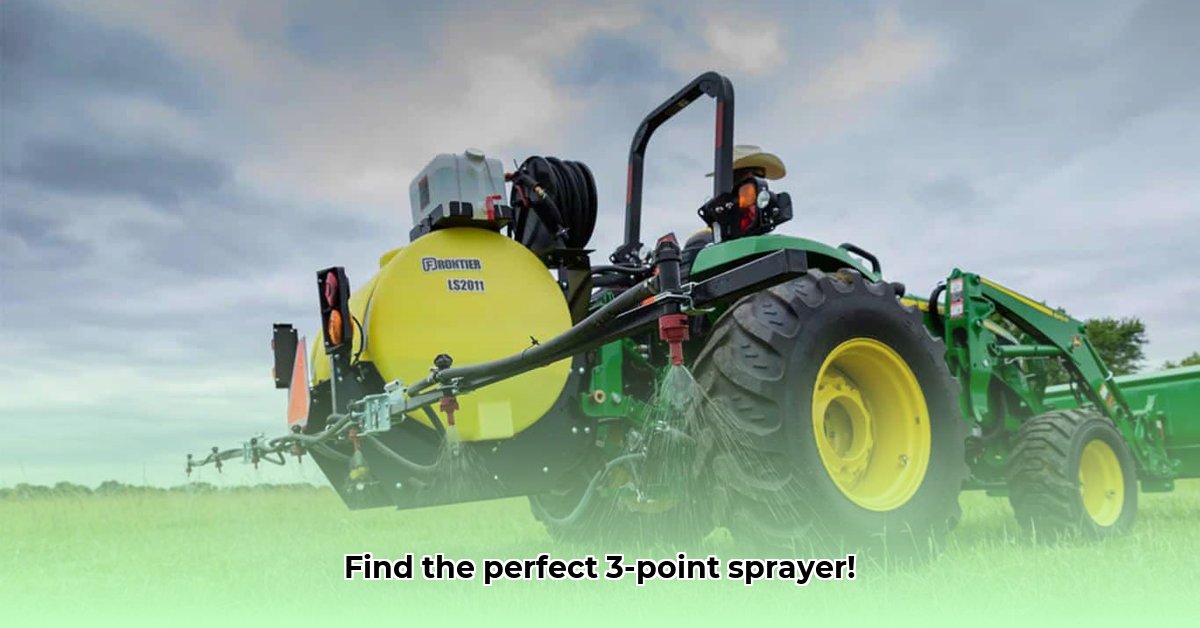
Choosing the right three-point sprayer for your tractor is a crucial investment impacting efficiency, yield, and environmental responsibility. This guide provides a comprehensive overview, assisting you in selecting and effectively utilizing a sprayer tailored to your farming operation. For more sprayer options, check out this helpful resource: tractor sprayers.
Understanding Your Needs: Assessing Acreage and Crop Type
Before considering specific sprayer features, assess your farm's requirements. How many acres do you cultivate? What crops do you grow? These factors directly influence the necessary tank capacity and boom width. A 50-gallon sprayer might suffice for a small orchard, while large-scale grain farming may necessitate a 1000-gallon model or larger. Different crops have varying spraying requirements, influencing nozzle selection and application techniques. Don't underestimate the impact of accurate assessment; it's the bedrock of efficient spraying.
Key Features and Specifications: Optimizing Performance
Several key features significantly affect a sprayer's performance and suitability.
Tank Capacity and Boom Width: Balancing Capacity and Coverage
Tank capacity dictates refill frequency, impacting efficiency. Larger tanks mean fewer interruptions, but increase weight and stress on your tractor. The boom width determines the swathe covered per pass; a wider boom enhances speed but necessitates careful navigation in confined spaces. Efficient spraying requires a balance between tank capacity and boom width based on your field size and crop type.
Pump Type: Selecting the Right Power Source
Three primary pump types exist:
- Diaphragm Pumps: Durable and relatively low maintenance, ideal for smaller operations.
- Centrifugal Pumps: Provide high flow rates suited to large tanks and wide booms, but may necessitate more frequent maintenance.
- Roller Pumps: Offer versatility, compromising between pressure and flow rate.
The optimal pump type depends on your specific requirements – prioritize high pressure for dense foliage or higher volume for large acreage.
Nozzle Type: Achieving Uniform Application
Nozzle selection is paramount for accurate droplet size and minimizing drift. Different nozzles cater to different chemicals and crops; research best practices for your specific needs, keeping drift potential and chemical properties in mind. Incorrect nozzle selection can reduce efficacy and increase environmental impact.
Pressure Regulation: Ensuring Consistent Application
Consistent spray pressure ensures uniform application, critical for maximizing effectiveness and minimizing waste. Look for sprayers with adjustable pressure settings, allowing precise control according to crop type and chemical properties. Precise pressure regulation is vital for achieving optimal spray coverage and reducing chemical waste.
Tractor Compatibility: Ensuring Seamless Integration
Before purchasing, verify compatibility with your tractor's specifications. The sprayer's weight, hydraulic requirements, and three-point hitch compatibility must align with your tractor’s capabilities. Ignoring tractor compatibility can lead to equipment failure and safety hazards.
Essential Features for Enhanced Efficiency
- Agitation: Prevents chemicals from settling, ensuring consistent mixture throughout the spraying process.
- Filtration: Protects nozzles from clogging, enhancing sprayer longevity and producing a cleaner spray.
- Pressure Gauges: Facilitate accurate monitoring and maintenance of consistent spray pressure.
- Rinsing Systems: Minimize chemical residue, preventing contamination and simplifying cleanup.
Setup and Operation: A Step-by-Step Guide
Attaching the Sprayer: Securely connect the sprayer to your tractor's three-point hitch, following the manufacturer's instructions precisely. Ensure a stable connection to avoid accidents.
Filling the Tank: Fill with your chosen mixture, strictly adhering to chemical label instructions. Prioritize safety—always wear appropriate protective gear.
Calibration: This crucial step ensures accurate chemical application per acre. Incorrect calibration leads to wasted chemicals and ineffective treatment. Follow your sprayer's instructions meticulously.
Adjusting Settings: Adjust spray pressure and nozzle settings based on the chemical and environmental conditions (wind, temperature).
Spraying: Maintain consistent speed and overlap passes for even coverage. Remain alert to surroundings and adhere to safety guidelines.
Maintenance and Troubleshooting: Extending Sprayer Lifespan
Regular maintenance is crucial for preserving your sprayer's longevity and performance.
Routine Inspections: Regularly inspect hoses, connections, and nozzles for leaks or damage.
Cleaning: Thoroughly clean the sprayer after each use. Follow the manufacturer’s instructions for cleaning solutions and procedures. This prevents future blockages and corrosion.
Part Replacement: Replace worn parts promptly. Neglecting maintenance leads to more significant and costly repairs in the long run.
Sustainability Considerations: Environmental Responsibility
Minimize environmental impact through responsible practices:
Timing: Spray on calm days to minimize drift.
Precise Application: Accurate calibration and nozzle selection reduces chemical usage and waste.
Water Conservation: Optimize water usage by using appropriate nozzles and spray techniques.
Conclusion: Making the Right Choice
Selecting the appropriate three-point sprayer is a pivotal decision. By carefully considering your specific needs and the factors outlined above, you can select a model that optimizes efficiency, effectiveness, and environmental sustainability. Always consult with agricultural equipment professionals for personalized advice.